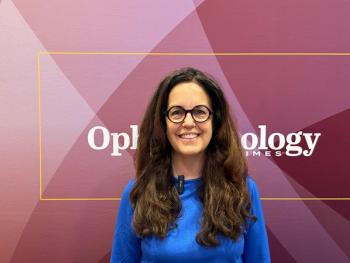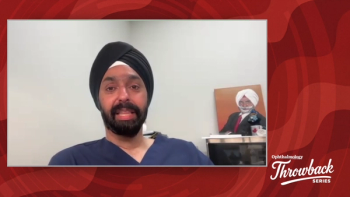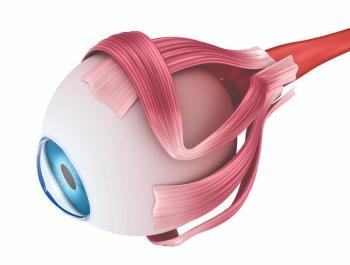
Online pachymetry, advanced eye-tracking improve LASIK
A new excimer laser platform (Technolas 100, Bausch & Lomb) is equipped with eye-tracking technology for static and dynamic eye alignment and can be integrated with online optical coherence pachymetry (OCP). Clinical experience demonstrates the performance of OCP and the value of static and dynamic rotational eye-tracking for improving LASIK outcomes.
Key Points
San Diego-Static eye-tracking, dynamic rotational eye-tracking (DRET), and online optical coherence pachymetry (OCP) all are important upgrades to modern excimer lasers for improving the efficacy and safety of laser vision correction procedures, said Barbara A.M. Lege, MD, at the annual meeting of the American Society of Cataract and Refractive Surgery.
Dr. Lege, ALZ Eye Clinic, Munich, reported on her center's experience in the past 2 years using a new excimer laser platform (Technolas 100, Bausch & Lomb) equipped with those technologies.
"OCP provides easy, precise, non-contact, real-time measurements of flap thickness and during the ablation, whereas static eye-tracking compensates for cyclotorsional rotation and DRET compensates for intraoperative rotation," Dr. Lege said. "It is erroneous to believe that a rotatoric misalignment only plays a role in eyes with higher astigmatism since every misalignment leads to loss in contrast sensitivity, especially the larger the pupil is. Therefore, DRET has much more impact on surgical results than any change in microkeratome or laser speed can contribute."
Online OCP also was used to measure flap thickness in a total of 1,859 eyes operated on between May 2005 and August 2006. The large series included 1,253 eyes that underwent 160-µm flap creation with a microkeratome (Hansatome, Bausch & Lomb), 136 eyes operated on with a newer microkeratome (Zyoptix XP, Bausch & Lomb) using the 120-µm head, and 470 eyes that had flap creation with the 30-kHz femtosecond laser (IntraLase, Advanced Medical Optics) set to achieve a flap thickness of 110 µm.
For all three groups, mean flap thickness was similar (range 121.4 to 126.5 µm). The range in values, however, was greatest in the older-microkeratome group (64 to 184 µm), and the standard deviation of the mean was significantly greater for that group as well (19.1 µm) compared with both the newer-microkeratome group (15.5 µm) and the femtosecond laser group (13.7 µm). No significant difference was seen between the variance of the femtosecond laser and the newer microkeratome.
Precise determination of flap thickness intraoperatively is an important safety feature for LASIK, Dr. Lege noted.
"It may be necessary to take less tissue in the ablation in order to decrease the risk of ectasia," she said.
As a future goal, Dr. Lege suggested that it would be desirable to be able to monitor the entire ablation zone in real time and feed the information back to the laser. Now, she said, "only the central thickness, where the cornea is thinnest, is monitored."
Retrospective analysis
To evaluate the outcomes impact of the addition of static and dynamic eye alignment to the laser platform, a retrospective analysis was conducted to compare results at 3 months after surgery in groups of eyes operated on with and without that technology. The contemporary treatment group was composed of 979 myopic eyes that underwent LASIK with the excimer laser using an aspheric ablation algorithm, static tracking and DRET, and visual axis centration.
The control group included 365 eyes that were enrolled several years earlier in an initial study of wavefront-guided LASIK. In that study, eyes were randomly assigned to treatment with either the first myopic LASIK wavefront algorithm or a proprietary algorithm (PlanoScan, Bausch & Lomb). The excimer laser had a 25-Hz eye-tracker, and centration was performed on the pupil.
The results demonstrated the superiority of the upgraded system. In the contemporary group, no eyes lost 2 or more lines of best-corrected visual acuity (BCVA) compared with a 3% loss rate in the controls. In addition, the efficacy ratio (3-month postop uncorrected visual acuity/preop BCVA) was 23% better in the contemporary treatment group, 1.04 versus 0.83. Whereas 18.4% of eyes from the initial wavefront study needed a re-treatment, the re-treatment rate with the contemporary technology was only 5.4%.
Another analysis was performed to evaluate the outcomes impact of the addition of static and dynamic eye alignment to the laser platform by recalculating the 3-month results with vector analysis to determine what the outcomes would have been without DRET or without DRET and the static rotational eye-tracker. (See "Tracking eye movements important".) The results also demonstrated the superiority of this upgraded system.
Newsletter
Don’t miss out—get Ophthalmology Times updates on the latest clinical advancements and expert interviews, straight to your inbox.



















































.png)


